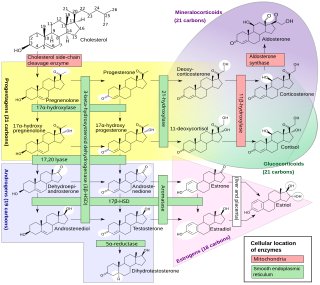Related Research Articles
Paraphilia is the experience of recurring or intense sexual arousal to atypical objects, situations, fantasies, behaviors, or individuals. It has also been defined as a sexual interest in anything other than a consenting human partner.
Gender identity is the personal sense of one's own gender. Gender identity can correlate with a person's assigned sex or can differ from it. In most individuals, the various biological determinants of sex are congruent, and consistent with the individual's gender identity. Gender expression typically reflects a person's gender identity, but this is not always the case. While a person may express behaviors, attitudes, and appearances consistent with a particular gender role, such expression may not necessarily reflect their gender identity. The term gender identity was coined by psychiatry professor Robert J. Stoller in 1964 and popularized by the controversial psychologist John Money.
Congenital adrenal hyperplasia (CAH) is a group of autosomal recessive disorders characterized by impaired cortisol synthesis. It results from the deficiency of one of the five enzymes required for the synthesis of cortisol in the adrenal cortex. Most of these disorders involve excessive or deficient production of hormones such as glucocorticoids, mineralocorticoids, or sex steroids, and can alter development of primary or secondary sex characteristics in some affected infants, children, or adults. It is one of the most common autosomal recessive disorders in humans.

Virilization or masculinization is the biological development of adult male characteristics in young males or females. Most of the changes of virilization are produced by androgens.

Congenital adrenal hyperplasia due to 11β-hydroxylase deficiency is a form of congenital adrenal hyperplasia (CAH) which produces a higher than normal amount of androgen, resulting from a defect in the gene encoding the enzyme steroid 11β-hydroxylase (11β-OH) which mediates the final step of cortisol synthesis in the adrenal. 11β-OH CAH results in hypertension due to excessive mineralocorticoid effects. It also causes excessive androgen production both before and after birth and can virilize a genetically female fetus or a child of either sex.

Congenital adrenal hyperplasia due to 21-hydroxylase deficiency, in all its forms, accounts for over 95% of diagnosed cases of congenital adrenal hyperplasia (CAH), and CAH in most contexts refers to 21-hydroxylase deficiency and different mutations related to enzyme impairment have been mapped on protein structure.

Intersex medical interventions, also known as intersex genital mutilations (IGM), are surgical, hormonal and other medical interventions performed to modify atypical or ambiguous genitalia and other sex characteristics, primarily for the purposes of making a person's appearance more typical and to reduce the likelihood of future problems. The history of intersex surgery has been characterized by controversy due to reports that surgery can compromise sexual function and sensation, and create lifelong health issues. Timing, evidence, necessity and indications for surgeries in infancy, adolescence or adult age have been controversial, associated with issues of consent.

The history of intersex surgery is intertwined with the development of the specialities of pediatric surgery, pediatric urology, and pediatric endocrinology, with our increasingly refined understanding of sexual differentiation, with the development of political advocacy groups united by a human qualified analysis, and in the last decade by doubts as to efficacy, and controversy over when and even whether some procedures should be performed.

Richard Green was an American-British sexologist, psychiatrist, lawyer, and author known for his research on homosexuality and transsexualism, specifically gender identity disorder in children. He is known for his behaviorism experiment in which he attempted to prevent male homosexuality and transsexuality by extinguishing feminine behavior in young boys. Despite this, throughout his career, he argued for the legal rights of sexual minorities. He later came to favor biological explanations for male homosexuality.
Gender incongruence is the state of having a gender identity that does not correspond to one's sex assigned at birth. This is experienced by people who identify as transgender or transsexual, and often results in gender dysphoria. The causes of gender incongruence have been studied for decades.

Sexuality in transgender individuals encompasses all the issues of sexuality of other groups, including establishing a sexual identity, learning to deal with one's sexual needs, and finding a partner, but may be complicated by issues of gender dysphoria, side effects of surgery, physiological and emotional effects of hormone replacement therapy, psychological aspects of expressing sexuality after medical transition, or social aspects of expressing their gender.
Childhood gender nonconformity (CGN) is a phenomenon in which prepubescent children do not conform to expected gender-related sociological or psychological patterns, or identify with the opposite sex/gender. Typical behavior among those who exhibit the phenomenon includes but is not limited to a propensity to cross-dress, refusal to take part in activities conventionally thought suitable for the gender and the exclusive choice of play-mates of the opposite sex.
Susan Jane Bradley is a Canadian psychiatrist. She has written many journal articles and books, including Gender Identity Disorder and Psychosexual Problems in Children and Adolescents and Affect Regulation and the Development of Psychopathology. Bradley was chair of the DSM-IV Subcommittee on Gender Disorders.
Ira Basil Pauly is an American psychiatrist who was an All American college football player at UCLA, and is known for his influential work on transsexualism.

The relationship between the environment and sexual orientation is a subject of research. In the study of sexual orientation, some researchers distinguish environmental influences from hormonal influences, while other researchers include biological influences such as prenatal hormones as part of environmental influences.

The hormonal theory of sexuality holds that, just as exposure to certain hormones plays a role in fetal sex differentiation, such exposure also influences the sexual orientation that emerges later in the individual. Prenatal hormones may be seen as the primary determinant of adult sexual orientation, or a co-factor with genes, biological factors and/or environmental and social conditions.
James Donald "Jim" Weinrich is an American sex researcher and psychobiologist. Much of his work examines the relationship of biology and sexual orientation. He won the Outstanding Contributions to Sexual Science Award at the 2011 Society for the Scientific Study of Sexuality (SSSS) Western Region annual meeting. He has also won the SSSS Hugo Beigel Award for the best paper published in The Journal of Sex Research. Weinrich served as the editor-in-chief of the Journal of Bisexuality from 2011 to 2014. He has also served on the editorial boards for The Journal of Sex Research and the Journal of Homosexuality.
Homosexuality was classified as a mental disorder in the Diagnostic and Statistical Manual of Mental Disorders (DSM) beginning with the first edition, published in 1952 by the American Psychiatric Association (APA). This classification was challenged by gay rights activists in the years following the 1969 Stonewall riots, and in December 1973, the APA board of trustees voted to declassify homosexuality as a mental disorder. In 1974, the DSM was updated and homosexuality was replaced with a new diagnostic code for individuals distressed by their homosexuality. Distress over one's sexual orientation remained in the manual, under different names, until the DSM-5 in 2013.

Intersex people are born with sex characteristics that "do not fit the typical definitions for male or female bodies". They are substantially more likely to identify as lesbian, gay, bisexual, or transgender (LGBT) than the non-intersex population, with an estimated 52% identifying as non-heterosexual and 8.5% to 20% experiencing gender dysphoria. Although many intersex people are heterosexual and cisgender, this overlap and "shared experiences of harm arising from dominant societal sex and gender norms" has led to intersex people often being included under the LGBT umbrella, with the acronym sometimes expanded to LGBTI. Some intersex activists and organisations have criticised this inclusion as distracting from intersex-specific issues such as involuntary medical interventions.

Intersex people are born with variations in physical and sex characteristics including those of the chromosomes, gonads, sex hormones, or genitals that, according to the UN Office of the High Commissioner for Human Rights, "do not fit the typical definitions for male or female bodies". Such variations may involve genital ambiguity, and combinations of chromosomal genotype and sexual phenotype other than XY-male and XX-female. Preimplantation genetic diagnosis allows the elimination of embryos and fetuses with intersex traits and thus has an impact on discrimination against intersex people.
References
- ↑ Kotulak, Ron (November 17, 2003). Homosexuality may be issue of brain chemistry. Chicago Tribune
- ↑ Staff report (February 5, 1995). Estrogen medication linked to homosexual tendencies. St. Louis Post-Dispatch
- ↑ Bradley SJ, Blanchard R, Coates SW, Green R, Levine SB, Meyer-Bahlburg HFL, Pauly IB, Zucker KJ (1991). Interim report of the DSM-IV Subcommittee on Gender Identity Disorders. Archives of Sexual Behavior Volume 20, Number 4 / August, 1991
- 1 2 Osborne, Duncan (October 28, 1997). An Attack On Our Most Vulnerable: The Use and Abuse of Gender Identity Disorder. Lesbian and Gay New York
- ↑ AA Ehrhardt and HF Meyer-Bahlburg (March 1981). Effects of prenatal sex hormones on gender-related behavior. Science 20 March 1981: Vol. 211. no. 4488, pp. 1312–1318